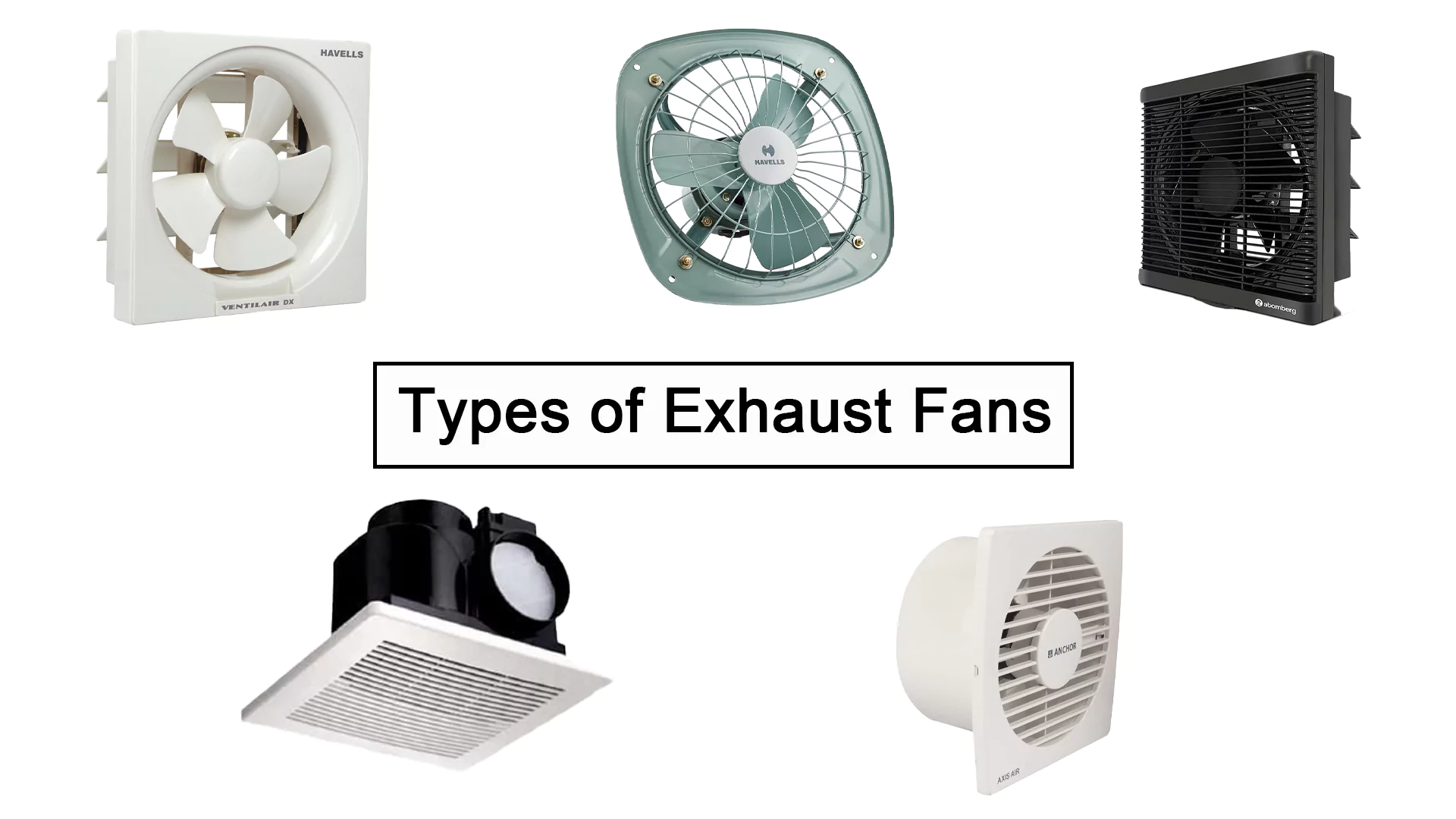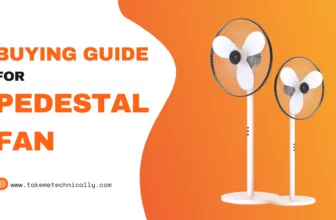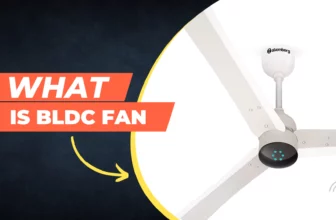
Are you in the market for a new exhaust fan but not sure where to start? The very first thing in any exhaust fan is its type. So, with so many types of exhaust fans available, it can be confusing to determine which one is right for your needs.
But don’t worry – in this article, we’ll break down the three main types of exhaust fans and help you figure out which one is best for you. We’ll also provide helpful buying guides to make the decision-making process even easier.
By the end of this article, you’ll have a solid understanding of the different types of exhaust fans and be able to confidently choose the one that fits your requirements. So let’s dive in and find the perfect exhaust fan for you!
Working Principle
The working principle of an exhaust fan is to provide good ventilation and improve air quality by removing stale and polluted air and replacing it with fresh, clean air. An exhaust fan is a fan that helps circulate air and remove stale or polluted air from a specific area. The fan works by using blades or propellers to create negative pressure, which draws air out of the room and into the ventilation system. This is important in areas where there is poor air circulation, such as bathrooms or kitchens.
Before you buy an exhaust fan, you should know its buying guide, which helps you find the best exhaust fan in India.
Types of Exhaust Fans
There are two types of exhaust fans and the third is a combo of both the first and second.
- Air Out
- Air in
- Air Out and Air In
Air Out
Ventilation fans are used to draw hot and stale air out of a room. This type of exhaust fan is typically made of plastic and has an aesthetically pleasing appearance.
Air In
These fans are known as fresh air or transparent fans, which draw fresh air from outside and blow it into the room or area.
Air Out and Air In
These are the two functions of dual-sided exhaust fans (also known as reversible exhaust fans). Metallic exhaust fans are typically designed as dual-sided, but some plastic exhaust fans can also be reversible and may have a button control to change the direction of airflow.
Also, check the best exhaust fan for the kitchen
Types of Ventilation:
- Medium Ventilation
- High Ventilation
- Extreme Ventilation
Different types of ventilation require different types of exhaust fans based on the size of the area and the environment.
Medium Ventilation:
If you are in need of an exhaust fan for your bathroom or kitchen, you can opt for a ventilation fan that fits your budget and requirements. Ventilation exhaust fans come in sizes ranging from 9 to 12 inches and consume less energy, using only 25 to 60 watts of electricity.
If you desire an exhaust fan that matches the modern style of your home and is ceiling-mounted, you can choose a ceiling fan. It will fit on your roof and provide efficient ventilation. A ceiling exhaust fan will blend seamlessly with your home’s decor and look natural.
High Ventilation:
You can improve the ventilation in your room by bringing in fresh air from outside. If you need an exhaust fan for a hotel, kitchen, or factory, you can choose this type because it is heavier than a ventilation fan and can blow fresh air into the room or area.
Extreme Ventilation:
If you require high-performance ventilation that can efficiently blow out the stale air from your room or area, then you can opt for a transfan.
For bathroom exhaust fans, you can choose a plastic one. For kitchen exhaust fans, you can opt for a metallic one because most metallic exhaust fans come with reversible and dual-sided air ventilation features.
Types of Exhaust Fans
- Ventilation Fan
- Fresher Air Fan
- Trans Fan
In the world of exhaust fans, there are three main types: ventilation fans, fresher air fans, and trans fans. Each one has its own design and purpose. Ventilation fans are ideal for general air circulation and the removal of stale air. Fresher air fans, as the name suggests, bring in fresh air from outside and circulate it within the room. Transfans are designed for high-performance ventilation and are suitable for industrial settings. Regardless of the type, all exhaust fans are designed to circulate air both inside and outside, helping to maintain a healthy and comfortable environment.
Ventilation Fan vs Fresh Air Fan vs Trans Fan
First of all, we will discuss the difference between a ventilation fan, a fresher fan, and a transparent fan
Ventilation Fan
These fans pull air from inside the room and exhaust it outside the home, making them suitable for use in bathrooms and kitchens. Ventilation fans are typically made of stainless steel or plastic, which makes them lightweight and compact.
Furthermore, ventilation fans are categorized into three types: ceiling ventilation fans, pipe ventilation fans, and normal ventilation fans.
Ceiling exhaust fans, pipe exhaust fans, and normal exhaust fans are all examples of ventilation fans. Ceiling exhaust fans are commonly used in modern houses, as they are installed on the ceiling and vent air out via a duct or pipe, maintaining the aesthetic of the ceiling. For limited spaces, pipe-type exhaust fans can be used, which can fit into a five-inch area and work efficiently.
Fresh Air Fan
Fresh air fans draw air from outside and circulate it inside the room. These fans usually come with a metal frame and grill protection. They are commonly used in large spaces like hotel kitchens and industrial areas.
Trans Fan
Trans fans also circulate fresh air, but they are heavier than fresh air fans and do not come with grill protection. They are designed for heavy-duty use in factories and warehouses. Transfans are made of stainless steel or iron material.
Looks and Design:
Appearance is important for every household appliance. When you install an appliance on the wall or in a window, it should match with the surroundings, otherwise, it can look unsightly. The design of the appliance should be appealing and the body is a key factor in its overall appearance.
Generally, exhaust fans are available in three types: plastic body, metallic with grill, and metallic body. We differentiate exhaust fans based on their look and design because they can provide valuable information about the fan and its use.
Plastic Body Ventilation Fan
These fans look pretty and are better than their other two counterparts because they are used in the home’s kitchens and bathrooms. They are aesthetically pleasing and consume less energy. The speed of these types of fans is approximately 1300 to 2500 RPM (revolutions per minute).
Metallic Fresh Air Fan
Fresh air fans are made of stainless steel or iron and are unsuitable for use as ventilation fans. They are used for large areas like hotel kitchens and are ideally suited for medium airflow.
Metallic Trans Air Fan
The trans fan looks like a fresh air fan, but it does not have a grill for protection because it is a heavy-duty exhaust fan. It can be used in factories in large areas.
Must, read Exhaust fan’s W consumption
Most people search for; What is CFM in exhaust fan?
CFM stands for Cubic Feet per Minute, which is a standard unit of measurement used to quantify the volume of air that a ventilation system can move in one minute. The larger the area, the higher the CFM rating required to effectively ventilate the space. It is generally recommended to have a ventilation rate of eight air changes per hour for optimal air quality.
For most bathrooms, a ventilation rate of one CFM per square foot of bathroom area is sufficient. For example, a bathroom measuring 7 feet by 10 feet would require a ventilation fan with a CFM rating of 70 to effectively remove moisture and odors from the space. It is important to choose a fan with a CFM rating high enough to replace the air in your bathroom at a rate of eight times per hour to maintain a healthy and comfortable living environment.
Conclusion
When buying an exhaust fan, it is critical to select the correct type of exhaust fan. In this post, we explored four basic exhaust fan subcategories: ceiling-mounted, wall-mounted, inline, and window-mounted, each having its own distinct features and applications. When choosing an exhaust fan, consider elements including airflow capacity, noise level, and energy economy. You can make an informed decision and choose the best exhaust fan for your unique needs if you understand the many types of exhaust fans available and their respective features. Read our other articles about exhaust fans and fans to get the best exhaust fan.








